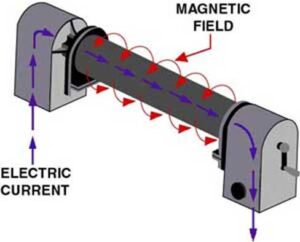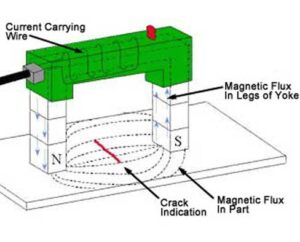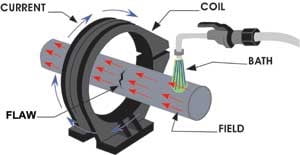Magnetization Methods
Several techniques are available to create a magnetic field within a component to facilitate evaluation through magnetic particle inspection. These methods are often categorized into two main groups: direct and indirect magnetizing methods.
Direct Magnetization
With direct magnetization, current is passed directly through the component. Whenever current flows, a magnetic field is produced. Usingthe Fleming’s right-hand rule, it is known that the magnetic lines of flux form perpendicular to the direction of the current and form a circular field in and around the conductor.

This method involves clamping the component between two electrical contacts in a special piece of equipment. Current is passed through the component and a circular magnetic field is established in and around the component.The strength of the induced magnetic field is proportional to the amount of current passed through the component.
When using the direct magnetization method, care must be taken to ensure that good electrical contact is established and maintained between the test equipment and the test component. Improper contact can result in arcing that may damage the component. It is also possible to overheat components in areas of high resistance such as the contact points and in areas of small cross-sectional area.
Indirect Magnetization
Indirect magnetization involves the utilization of a potent external magnetic field to generate a magnetic field within the component. Similar to direct magnetization, there exist various approaches through which indirect magnetization can be achieved.
Adjustable horseshoe electromagnets, known as yokes, resolve the challenges linked to permanent magnets and find widespread application in industrial settings. Electromagnets manifest magnetic flux solely when an electric current circulates through the soft iron core. Placing the magnet onto the component creates a magnetic field that spans between the magnet’s north and south poles.

Another approach to indirectly induce a magnetic field within a material involves harnessing the magnetic field generated by a current-carrying conductor. For cylindrical components, a circular magnetic field can be instituted using a central conductor. Typically, one or more cylindrical components are suspended from a solid copper bar inserted through their inner diameters. By passing current through the copper bar, a circular magnetic field ensues, establishing the desired magnetic field within the test components.

A third method of indirect magnetization involves employing coils and solenoids. In cases where a component’s length significantly surpasses its diameter, a longitudinal magnetic field can be engendered within the component. The component is positioned lengthwise within the concentrated magnetic field present at the core of a coil or solenoid. This magnetization technique is commonly referred to as a “coil shot.”

However, when aiming to create a longitudinal magnetic field within a component using a coil, the ratio between its length and its diameter plays a pivotal role. If the length dimension doesn’t notably exceed the diameter or thickness dimension, achieving a field strength sufficient to generate an indication becomes exceedingly challenging. Typically, a minimum L/D (length-to-diameter) ratio of two is necessary for effective results.
